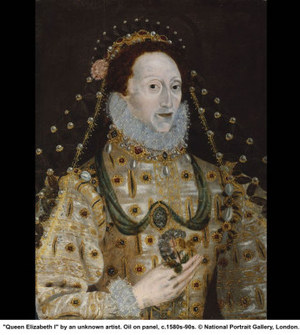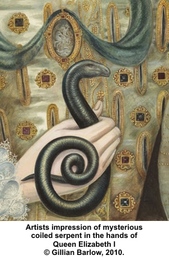The National Portrait Gallery in London has a nifty mystery on its hands, which it is revealing in an exhibit that opens Saturday. A painting of Elizabeth I, which has been in storage since 1921, is going on view in Concealed and Revealed: The Changing Faces of Elizabeth I, along with three others of the virgin queen.
 Here’s the mystery: The painting, made by an unknown artist in the 1580s or early 1590s, has degraded and now shows signs that the Queen is, or was, holding a coiled serpent. Why, what it signifies and why it was painted over “shortly after” it was orginally painted are all unclear. Here’s what the NPG says:
Here’s the mystery: The painting, made by an unknown artist in the 1580s or early 1590s, has degraded and now shows signs that the Queen is, or was, holding a coiled serpent. Why, what it signifies and why it was painted over “shortly after” it was orginally painted are all unclear. Here’s what the NPG says:
Paint analysis has shown that the snake was part of the original design, painted at the same time as the rest of the portrait, and Elizabeth’s fingers were originally clasped around the snake…At the final stage of painting a decision was made not to include this emblem, and the Queen was shown holding a small bunch of roses instead.
 The work in question was also, strangely, painted over an unfinished portrait of an unWhnknown sitter, “a female head facing in the opposite direction and in a higher position than the queen. The eyes and nose of the first face can be seen where paint has been lost from Elizabeth’s forehead.”
The work in question was also, strangely, painted over an unfinished portrait of an unWhnknown sitter, “a female head facing in the opposite direction and in a higher position than the queen. The eyes and nose of the first face can be seen where paint has been lost from Elizabeth’s forehead.”
But reusing panels was common then (and since then). Speculating on the serpent is more fun. The NPG says:
A serpent was sometimes used to represent wisdom, prudence and reasoned judgment – all fitting attributes for a Queen – but in the Christian tradition serpents have also been used to represent Satan and original sin. The removal of the snake may therefore have been due to the ambiguity of the emblem. The snake is mainly black, but has greenish blue scales and was almost certainly painted from imagination.
The NPG doesn’t mention the religious wars of the time, but it’s a good bet they played a role.
You can read more about the exhibit, which remains on view until Sept. 26, here. The scientific examinations, along with this and other exhibitions, are part of the NPG’s Making Art in Tudor Britain project led by Dr Tarnya Cooper.
People love things like this — at least, that’s what I see whenever I visit exhibitions with a conservation or investigative component. And mysteries are worthy not only of exhibitions, but perhaps also of TV programs, like art crime TV?
Photo Credit: Courtesy of the National Portrait Gallery, London, copyright as above
